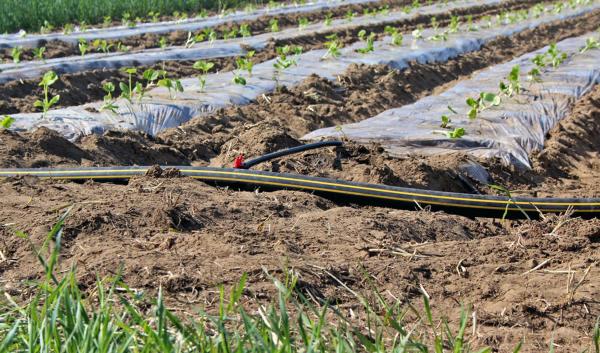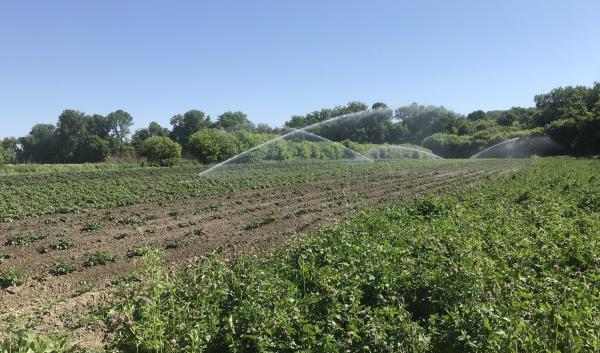Leer en español: Cultivar la llanura aluvial: Soluciones intermedias y oportunidades
Climate change will alter rainfall patterns in New England in the coming decades.
Storms will likely become more intense, increasing the frequency of flooding. This leaves many agricultural lands, especially those in floodplains, at risk. Farms in New England tend to be concentrated in river valleys because the soils are fertile and easily cultivated. Thus, many farms in this area are vulnerable to floods. Storms such as nor’easters and hurricanes are of particular concern because they can have very high rates of precipitation. For example, in 2011, Tropical Storm Irene hit the East Coast of the United States. Intense rains caused rivers in western Massachusetts to reach record high levels. An estimated 15,400 acres of farmland in western Massachusetts and Vermont were damaged during the storm. The economic impact of this storm on agriculture was about $20 million USD. Flooding on farmlands can cause many types of damage. They may include crop loss, contamination, soil erosion, equipment loss, debris deposition, and the spread of invasive species. In New England, farms are important to the regional economy and food supply. Luckily, farmers have a number of solutions available on-line for reducing the impact of increasing flood risk due to climate change.
Research brief Classroom materialsFlood management tradeoffs
Floodplain management strategies in agricultural areas can take many forms. Practices to reduce risks affect the local river ecosystem but can also impact environments downstream. For example, farmers can protect their land from floods by planting trees, changing their crops types, or restoring riparian vegetation. Such measures can help lessen flooding impacts on farmlands as well as downstream areas. Other strategies such as dredging or straightening the river, stabilizing the streambank, constructing a levee, or enhancing drainage may help only the very localized area. Yet these practices may actually increase the intensity of water flow. This can exacerbate flooding downstream and degrade river ecosystems.
Interviews with floodplain stakeholders
In 2014, we interviewed 36 residents and farmers in the Deerfield River watershed in western Massachusetts. This area has experienced significant flooding in recent years. Some residents proposed that all the land bordering rivers should be restored to natural forests. The forests would increase water infiltration, protect banks form erosion and reduce flooding. This practice, however, could also have negative impacts on farmers and the local economy. Effective stream governance strategies often require that all stakeholder groups have their goals and concerns addressed. Any river governance system should identify who has the authority to manage river and stream corridors. This person or group sets rules that determine the flood risk for farmers and downstream communities. The potential impacts of each management strategy should be weighed and analyzed for specific floodplain areas. This allows managers to make informed decisions while balancing the needs of a diverse set of stakeholders.
Teaching tradeoffs and floodplain resilience
As the climate changes, farmers and community stakeholders in New England will need to adapt to changing rainfall patterns. We created a curriculum to facilitate learning and discussion of this issue. The content is based on interviews we did with floodplain stakeholders. Lessons look at strategies that can help protect farms, downstream communities, and river ecosystems from floods (Table 1). This teaching tool was designed for use by educators. Teaching guides and a slide show support the interactive lessons and role-playing scenarios. The focus is on socio-environmental tradeoffs. Participants need to consider complex social, economic, political, and environmental aspects to address the issue. The goal is to balance ecosystem conservation, agricultural production, and community needs.
To date, the curriculum has been used in several group settings. Materials helped guide roundtable discussions between farmers and RiverSmart. RiverSmart is a research group that has studied resilience to river flooding, farming vulnerability, and adaptation strategies. The curriculum was also used to help students learn about and develop sustainable river governance practices in an era of climate change. The curriculum materials are copyrighted under a Creative Commons license (CC BY-NC-SA) and are free for anyone to use. These resources were developed through the 2016 Case Studies for Teaching Short Course. We thank the National Socio-Environmental Synthesis Center (SESYNC) for their support of the program.
| Practice | Objective | Trade-off |
|---|---|---|
| Bank Stabilization/dredging | Protect land from erosion; protect infrastructure | Increases flood impacts downstream; degrades river ecosystems |
| Land use change/riparian restoration | Slow flood waters; prevent erosion | Expensive for farmers and may reduce farm area |
| Flood Insurance | Protect livelihood from loss | Expensive for farmers |
| Levee/block flood waters | Protect croplands from flood impacts | Increases flood impacts downstream |
| Drainage infrastructure | Reduce flooding | Increases flood impacts downstream; degrades river ecosystem |
| Flood debris removal | Preserve or boost cropland productivity; protect farmer’s health and safety | Expensive for farmers |
| Regrading fields | Restore cropland productivity after deposition | Expensive for farmers |




